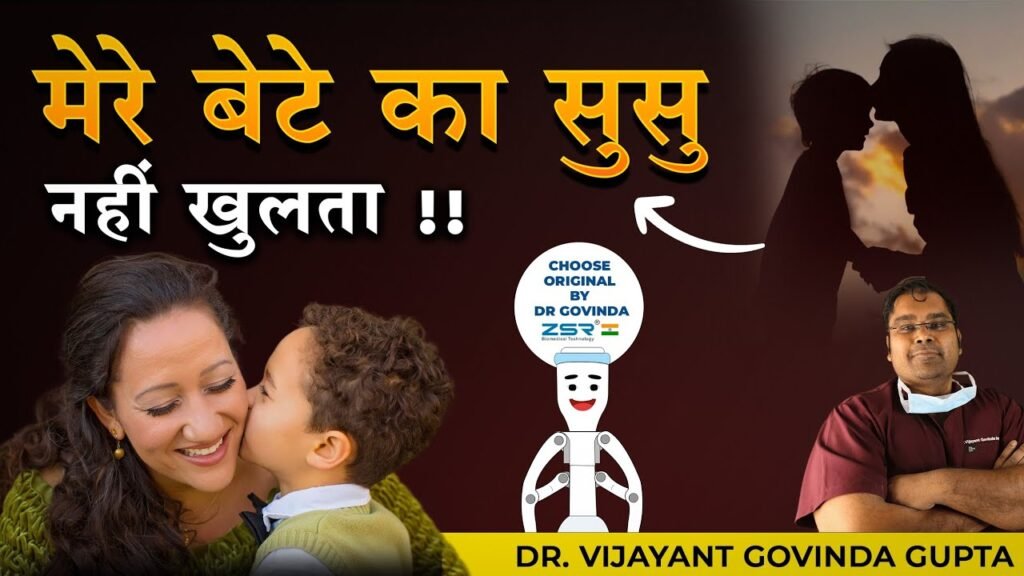Phimosis in children is a common condition that affects many boys, often raising concerns for parents. It involves the inability to retract the foreskin over the glans (head) of the penis. While this condition is normal in infants and young boys, persistent or severe cases may require medical attention. This blog explores Phimosis in boys, its causes, symptoms, and treatment options, including Circumcision in Children, ZSR Circumcision in Children, and other approaches to managing Pediatric phimosis and foreskin problems. We’ll also address common questions about बच्चों में खतना (circumcision in children) to provide clarity for parents seeking reliable information.

What is Phimosis in Children?
Phimosis is a condition where the foreskin is too tight to be pulled back over the glans penis. In newborns and young boys, this is a normal physiological condition known as physiological phimosis, as the foreskin is naturally adherent to the glans at birth. Over time, as the child grows, the foreskin usually separates and becomes retractable. However, in some cases, the foreskin remains non-retractable, leading to pathological phimosis, which may cause discomfort or complications.
Types of Phimosis in Boys
- Physiological Phimosis: Common in infants and young boys, this is a natural condition that typically resolves without intervention by adolescence.
- Pathological Phimosis: Caused by scarring, infection, or inflammation, this type may require medical treatment.
Pediatric phimosis and foreskin problems are often noticed when parents attempt to clean the penis or during routine pediatric checkups. Understanding the difference between these types is crucial for determining whether intervention, such as Pediatric circumcision, is necessary.
Symptoms of Phimosis in Boys
Parents should be aware of the signs of Phimosis in boys to seek timely medical advice. Common symptoms include:
- Difficulty retracting the foreskin: The foreskin cannot be pulled back over the glans, even partially.
- Pain or discomfort: Especially during urination or when the foreskin is manipulated.
- Ballooning of the foreskin: The foreskin may inflate during urination due to trapped urine.
- Recurrent infections: Conditions like balanitis (inflammation of the glans) or balanoposthitis (inflammation of the glans and foreskin) may occur.
- Redness or swelling: Around the foreskin or glans, indicating irritation or infection.
If these symptoms persist or worsen, consulting a pediatrician or urologist is essential to address Pediatric phimosis and foreskin problems.
Causes of Phimosis in Children
Phimosis in boys can result from various factors:
- Natural development: Physiological phimosis is a normal part of development in young boys.
- Infections: Repeated infections like balanitis can cause scarring, leading to pathological phimosis.
- Injury or trauma: Forced retraction of the foreskin can cause tears and scarring.
- Skin conditions: Conditions like lichen sclerosus can tighten the foreskin, contributing to phimosis.
- Poor hygiene: Accumulation of smegma (a natural substance under the foreskin) can lead to irritation or infection.
Understanding these causes helps parents take preventive measures and seek appropriate treatment, whether through conservative methods or Circumcision in Children.
Diagnosis of Phimosis in Boys
Diagnosing Phimosis in boys typically involves a physical examination by a pediatrician or pediatric urologist. The doctor will assess the foreskin’s retractability and check for signs of infection, scarring, or other abnormalities. In most cases, no imaging or tests are required unless complications like urinary tract infections (UTIs) are suspected.
Parents should avoid forcibly retracting the foreskin, as this can cause pain, bleeding, or further complications. Gentle cleaning and proper hygiene are usually sufficient for physiological phimosis.
Treatment Options for Phimosis in Children
The treatment for Pediatric phimosis and foreskin problems depends on the severity, age of the child, and underlying cause. Here are the common approaches:
1. Conservative (Non-Surgical) Treatments
For mild cases of physiological phimosis, non-surgical treatments are often effective:
- Observation: Many cases resolve naturally by puberty, requiring only regular monitoring.
- Steroid creams: Topical corticosteroids, prescribed by a doctor, can soften the foreskin and improve retractability over a few weeks.
- Proper hygiene: Gentle cleaning under the foreskin (once retractable) prevents infections and smegma buildup.
- Stretching exercises: Under medical guidance, gentle stretching can help loosen the foreskin.
2. Circumcision in Children
When conservative treatments fail or pathological phimosis causes complications, Pediatric circumcision may be recommended. Circumcision involves the surgical removal of the foreskin and is one of the most common procedures for treating phimosis.
Types of Circumcision
- Traditional Circumcision: Performed under general anesthesia in a hospital setting, this method uses a scalpel to remove the foreskin.
- ZSR Circumcision in Children: A modern, minimally invasive technique using a stapler device, ZSR circumcision offers faster recovery, less pain, and minimal scarring. It’s gaining popularity for बच्चों में खतना due to its precision and reduced complications.
- Laser Circumcision: Uses laser technology for precise cutting, reducing bleeding and recovery time.
Benefits of Circumcision in Children
- Resolves phimosis permanently.
- Reduces the risk of recurrent infections like balanitis.
- Improves hygiene by eliminating the need to retract the foreskin.
- May lower the risk of UTIs and certain sexually transmitted infections later in life.
Risks of Circumcision
While generally safe, circumcision carries minor risks, including:
- Bleeding or infection at the surgical site.
- Pain or discomfort during recovery.
- Rare complications like excessive scarring or improper healing.
Parents considering Circumcision in Children should discuss the procedure’s benefits and risks with a pediatric urologist to make an informed decision.
3. Preputioplasty
For parents hesitant about circumcision, preputioplasty is a less invasive alternative. This procedure widens the foreskin without removing it, preserving its natural appearance and function. It’s suitable for select cases but may not be effective for severe phimosis.
ZSR Circumcision in Children: A Modern Approach
ZSR Circumcision in Children is a revolutionary technique that uses a disposable stapler device to remove the foreskin. This method is particularly appealing for बच्चों में खतना due to its advantages:
- Minimally invasive: Requires smaller incisions, reducing tissue damage.
- Faster recovery: Most children resume normal activities within a few days.
- Reduced bleeding: The stapler seals blood vessels during the procedure.
- Lower pain levels: Less post-operative discomfort compared to traditional methods.
Parents opting for ZSR Circumcision should ensure the procedure is performed by a trained pediatric surgeon in a sterile environment to minimize risks.
Caring for a Child After Circumcision
Post-circumcision care is critical to ensure proper healing and prevent complications. Here are some tips:
- Keep the area clean: Gently clean the penis with warm water and mild soap as advised by the doctor.
- Apply ointments: Use petroleum jelly or prescribed creams to prevent the penis from sticking to diapers or clothing.
- Monitor for complications: Watch for excessive bleeding, swelling, or signs of infection (redness, pus, or fever).
- Avoid strenuous activities: Limit physical activity for a few days to promote healing.
- Follow-up visits: Attend all scheduled appointments to ensure proper recovery.
Read Also
- Urinary Tract Infection (UTI) – Symptoms and Causes
- Testosterone Replacement Therapy: Benefits, Risks, and Realities
- Sebaceous Cysts: Causes, Symptoms, and Treatment
- Sildenafil (Viagra) vs. Tadalafil: Which is Right for You?
Addressing Common Concerns About Circumcision in Children
Circumcision in Children, or बच्चों में खतना, is a topic that raises many questions for parents. Here are some common concerns:
- Is circumcision painful? The procedure is performed under anesthesia, so the child feels no pain during surgery. Post-operative discomfort is manageable with pain relief.
- Will circumcision affect my child’s health? When performed correctly, circumcision has minimal long-term effects and may offer health benefits.
- Is ZSR circumcision safe for young children? Yes, ZSR Circumcision in Children is safe when done by a qualified surgeon, with fewer complications than traditional methods.
- Can phimosis recur after circumcision? Circumcision permanently resolves phimosis, as the foreskin is removed.
Phimosis in boys is a common condition that often resolves naturally but may require medical intervention in some cases. Understanding the symptoms, causes, and treatment options, including Circumcision in Children, ZSR Circumcision in Children, and conservative therapies, empowers parents to make informed decisions. By addressing Pediatric phimosis and foreskin problems early, parents can ensure their child’s comfort and long-term health. For personalized advice, consult a pediatrician or urologist to discuss the best approach for your child.

